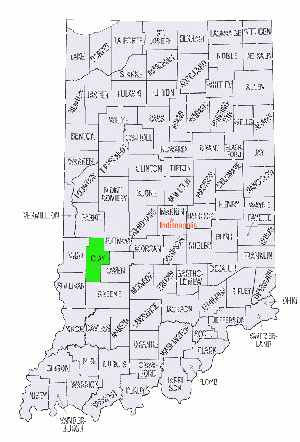Difference between revisions of "Clay County (Indiana, USA)"
| [checked revision] | [checked revision] |
GameoAdmin (talk | contribs) (CSV import - 20130823) |
SamSteiner (talk | contribs) |
||
| (One intermediate revision by one other user not shown) | |||
| Line 1: | Line 1: | ||
[[File:IN-Clay.gif|300px|thumb|right|''Clay County, Indiana. | [[File:IN-Clay.gif|300px|thumb|right|''Clay County, Indiana. | ||
| − | U.S. Census TIGER/Line map'']] Clay County, [[Indiana (USA)|Indiana]], south of the west-central part of the state, with a population of 30,000 in the mid-1950s (26,000 in 2000), was formed by statute in 1825. In the early days it was a coal-mining center, but when coal began to fail, ten clay plants were in operation. With [[Owen County (Indiana, USA)|Owen County]] (population 13,000) on the east, the location of McCormicks Creek State Park, it became the home of a small struggling ultraconservative Mennonite settlement about 1860, made up chiefly of settlers who had come originally from [[Rockingham County (Virginia, USA) |Rockingham County]], [[Virginia (USA)|Virginia]], to [[Fairfield County (Ohio, USA)|Fairfield County]], [[Ohio ( | + | U.S. Census TIGER/Line map'']] Clay County, [[Indiana (USA)|Indiana]], south of the west-central part of the state, with a population of 30,000 in the mid-1950s (26,000 in 2000), was formed by statute in 1825. In the early days it was a coal-mining center, but when coal began to fail, ten clay plants were in operation. With [[Owen County (Indiana, USA)|Owen County]] (population 13,000) on the east, the location of McCormicks Creek State Park, it became the home of a small struggling ultraconservative Mennonite settlement about 1860, made up chiefly of settlers who had come originally from [[Rockingham County (Virginia, USA) |Rockingham County]], [[Virginia (USA)|Virginia]], to [[Fairfield County (Ohio, USA)|Fairfield County]], [[Ohio (USA)|Ohio]], then to [[Logan County (Ohio, USA)|Logan County]], Ohio, where a small Mennonite settlement died out about 1869. Deacon George Funk, son of Bishop Daniel Funk of the extinct Mennonite church in Logan County, was one of the last ordained men in the congregation. Descendants of the Mennonites who remained in the community united with other denominations. One became a Methodist minister. Matthias Cooprider, grandfather of [[Friesen, Florence Cooprider (1887-1985)|Dr. Florence Cooprider Friesen]], moved from Clay City in southern Clay County to [[Marion County (Kansas, USA)|Marion County]], [[Kansas (USA)|Kansas,]] in 1876 and married as his third wife, the widow of Henry Brunk, father of [[Brunk, George R. (1871-1938)|George R. Brunk]]. |
{{GAMEO_footer|hp=Vol. 1, p. 620|date=1953|a1_last=Umble|a1_first=John S|a2_last=|a2_first=}} | {{GAMEO_footer|hp=Vol. 1, p. 620|date=1953|a1_last=Umble|a1_first=John S|a2_last=|a2_first=}} | ||
| + | [[Category:Places]] | ||
| + | [[Category:Counties/Regional Governments]] | ||
| + | [[Category:Counties/Regional Governments in Indiana]] | ||
| + | [[Category:Counties/Regional Governments in the United States]] | ||
Latest revision as of 19:26, 5 March 2021
Clay County, Indiana, south of the west-central part of the state, with a population of 30,000 in the mid-1950s (26,000 in 2000), was formed by statute in 1825. In the early days it was a coal-mining center, but when coal began to fail, ten clay plants were in operation. With Owen County (population 13,000) on the east, the location of McCormicks Creek State Park, it became the home of a small struggling ultraconservative Mennonite settlement about 1860, made up chiefly of settlers who had come originally from Rockingham County, Virginia, to Fairfield County, Ohio, then to Logan County, Ohio, where a small Mennonite settlement died out about 1869. Deacon George Funk, son of Bishop Daniel Funk of the extinct Mennonite church in Logan County, was one of the last ordained men in the congregation. Descendants of the Mennonites who remained in the community united with other denominations. One became a Methodist minister. Matthias Cooprider, grandfather of Dr. Florence Cooprider Friesen, moved from Clay City in southern Clay County to Marion County, Kansas, in 1876 and married as his third wife, the widow of Henry Brunk, father of George R. Brunk.
| Author(s) | John S Umble |
|---|---|
| Date Published | 1953 |
Cite This Article
MLA style
Umble, John S. "Clay County (Indiana, USA)." Global Anabaptist Mennonite Encyclopedia Online. 1953. Web. 24 Nov 2024. https://gameo.org/index.php?title=Clay_County_(Indiana,_USA)&oldid=170522.
APA style
Umble, John S. (1953). Clay County (Indiana, USA). Global Anabaptist Mennonite Encyclopedia Online. Retrieved 24 November 2024, from https://gameo.org/index.php?title=Clay_County_(Indiana,_USA)&oldid=170522.
Adapted by permission of Herald Press, Harrisonburg, Virginia, from Mennonite Encyclopedia, Vol. 1, p. 620. All rights reserved.
©1996-2024 by the Global Anabaptist Mennonite Encyclopedia Online. All rights reserved.

